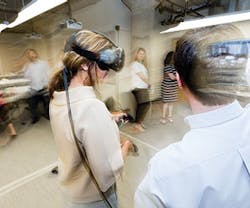Corgan is a 78-year-old architecture firm, but these days the team is behaving a bit like teenagers with a new video game thanks to virtual reality, which the company is using as a tool to help clients and designers alike experience immersive 3D models of projects at key points in the design process.
As a full-service architecture and interior design firm working across many sectors—from aviation to healthcare, corporate office, data centers, and education—Corgan is acutely aware of the need to tell design stories to a wide variety of audiences. With that, the firm founded an offshoot, Corgan MediaLab, dedicated to telling stories in all mediums. The MediaLab is led by deep talent from the animation and gaming worlds who have been watching virtual reality tools for years, waiting for the platform to make sense for our business.
“We are encouraged to experiment; that’s the mission of the MediaLab,” said executive creative director Brandon Carmichael. “A lot of that experimentation comes from trying things out as they hit the market and determining what works for Corgan and our clients. Of course, it doesn’t hurt that I’ve been obsessed with gaming since I was a kid.”
But what thrills the gamers is not always the best fit for clients, nor does it always sync up effectively with the BIM platforms we are already using. So the MediaLab went to work, integrating HTC Vive VR headsets and working closely with the internal team at Iris VR to beta test a new program called Prospect.
Today, Prospect allows the Corgan design team to convert a Revit or SketchUp file into VR with just a few clicks. After that, individuals can wear the headset and use the tool to work through design options, making mark-ups as they go.
Seeing really is believing in this case. Before taking Prospect to clients, we tested the program on ourselves. Carmichael and his team set up VR environments in five Corgan offices across the country so our teams could experience the possibilities first hand. The holiday advertisements for VR goggles are pretty accurate—there is a lot of “ohhh,” “ahhh,” and “Oh my gosh!” heard.
For some, getting past the cool factor is when the possibilities really start to emerge. With the click of a button, the program allows us to change the time of day so we can experience the space as the sun moves through the sky. We can turn materials on and off while virtually standing in the model. And we can make notes in the model, so that the team watching on the monitor can easily see where changes should be made.
It’s a special kind of fun to put the goggles on clients, giving them the opportunity to “walk through” their unbuilt projects and see everything from shell to finishes. But the greatest value I anticipate is actually with the design team and our ability to work out design options, foresee challenges, and address them efficiently with a new level of confidence. Could all of these things be done in traditional rendering and modeling? Of course, but the game changer here is the effectiveness of the program. The ability to take the model as is and use it in virtual reality allows this tool to fold in and enhance the design process without impacting the technology workflow that is already in place.
We have used the tool in multiple client presentations at this point, including airport terminals and corporate headquarters. But the greatest test to date was in a showroom project, working with Mannington on its new Atlanta space. The Corgan team on the job chose to utilize VR as part of the client presentation during design development.
We presented the “traditional” view first, with plans, sketches, and still renderings. Then, after laying the groundwork, we put our clients in the goggles to “walk” the space. Those who attended the presentation stated that the VR experience had made the conversation with the design team a richer one. It was wonderful to see the increased level of confidence in decision making when we used VR in conjunction with traditional presentation tools.
When reflecting on projects that have been both exceptional and enjoyable, they all tend to have something in common. It’s neither size nor budget, but the trust that was built between design team and client. The potential of VR goes far beyond being on the cutting edge—it will help build that trust and assist clients in making informed decisions with their team. That is cool.
During her tenure with Corgan, Lindsay Wilson, executive managing principal, interiors market sector leader, has grown the interior design studio’s staff, increased billings, and earned national recognition for expertise in corporate interior projects. She was recently named to the firm’s executive committee, making her the first interior designer in the firm’s 78-year history to achieve that leadership position.
